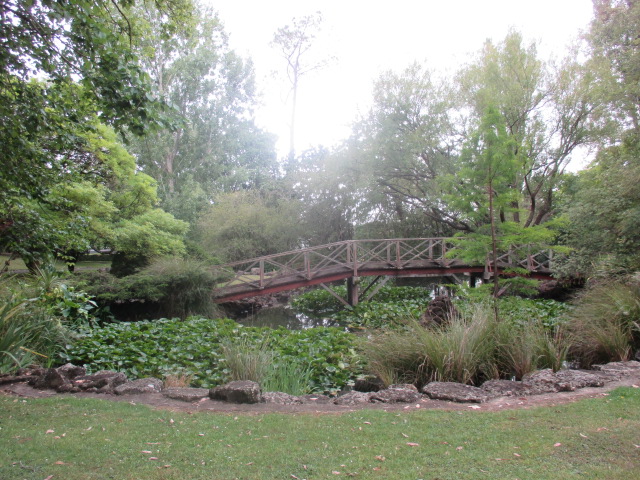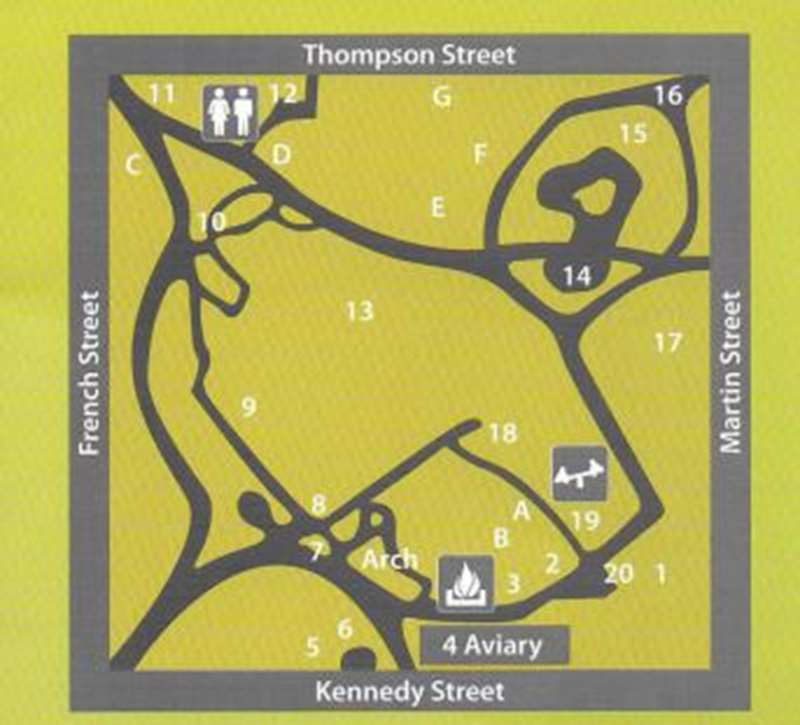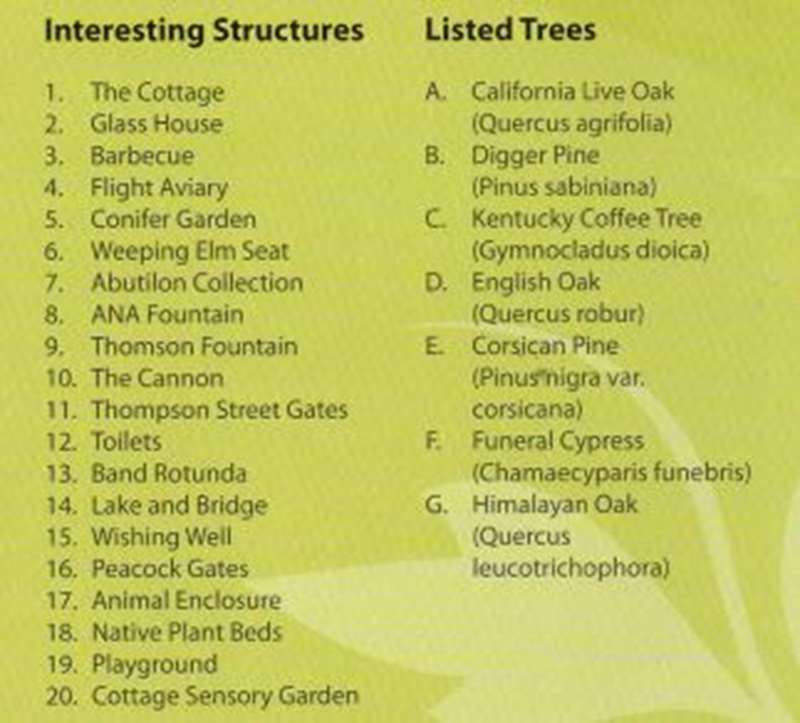Hamilton Botanic Gardens


The site for the Hamilton Botanic Gardens was set aside in 1853 and first planted in 1870 which makes them one of the earliest provincial botanic gardens in Australia.
William Guilfoyle, the curator of the Royal Botanic Gardens and one of Australia's greatest garden designers and botanists, designed sweeping lawns, curved paths, lakes and islands, rockeries, cacti and succulents, colourful plants and contrasting foliage.
The gardens were classified by the National Trust of Victoria in 1990 and contain eight tree species listed on the Register of Significant Trees in Victoria. Significant plants include the State's only known Gymnocladus dioicus (Kentucky Coffee Tree) and largest known Chamaecyparis funebris (Funeral Cypress), as well as two rare Quercus leucotrichophora (Himalayan Oaks).
Zoological elements have been a feature of the gardens since 1885, with two aviaries and an animal enclosure remaining.
Set in four acres, the Gardens are bounded by French, Kennedy, Martin and Thompson Streets in Hamilton.
History of the Gardens
The site for the Gardens was set aside in 1853 and first planted by William Ferguson in 1870, making the gardens amongst the earliest provincial botanic gardens set aside in Australia.
From 1881, the Council of the time employed William Guilfoyle, curator of the Melbourne Botanic Gardens, to draw up plans and design the layout of the gardens. His design approach was to introduce sweeping lawns, curved paths, lakes and islands, rockeries with cacti and succulents, colourful plants and contrasting foliage into the Hamilton Botanic Gardens.
Guilfoyle's first list of sketch plans and suggested plantings, now more than 100 years old, are held in the Hamilton Art Gallery.
The plant list he prepared included popular "Guilfoyle signature plants", and comprised Cordyline, Ficus, Cupressus, Pinus, Ulmus, Quercus, Populus, Viburnum, Wigandia, Ricinus, and Australian and New Zealand natives, lakeside and water plants, succulents, bulbs and tubers, medicinal and economic genera, variegated and colourful shrubs, and palms.
Guilfoyle was able to design a garden that was a balance between aesthetic and recreational requirements, and scientific purposes. This ability has created a unique landscape style and his gardens today are considered a vital part of Victoria's heritage.
Set in four hectares, the Gardens as a complete entity were classified by the National Trust of Victoria in 1990 and contain eight tree species listed on the Register of Significant Trees in Victoria. An appropriate notice is attached to each important characteristics of the gardens include:
- The planting of specimen trees, shrubberies and areas of scientific interest befitting the role of a botanic garden.
- The garden structures, fountains, decorative fences and gates.
- The retention of animal and bird enclosures, which illustrate the nineteenth century fashion for menageries.
- The manner in which the gardens and surrounding street-scapes merge to give pleasing vistas both inwards and outwards.
Map of the Gardens


What to look for in the Gardens
The Cottage (1) was built in 1881 originally adjoining the fence along French Street. It was moved to its present location in 1907 and was modified, remaining the Botanic Gardens superintendent's residence until 1995. The Cottage was then externally restored to its original plan from 1881.
The Cottage Sensory Garden (20) was designed for access for all and is maintained by the Friends of the Botanic Gardens.
The Glass House (2) was a gift from the Country Women's Association and is used for flower displays in season. Near the Barbeque (3) are two listed trees, a Californian Oak and a Digger Pine (A & B).
The Flight Aviary (4) was erected in 1979 with financial assistance from the Australian Natives Association.
The seat around the base of the Weeping Elm (6) has been donated by the Friends of the Hamilton Botanic Gardens. The Abutilon collection (7) represents a more specialised plant group befitting the scientific role of the Gardens. The bowl shaped ANA Fountain (8) was built of local stone in 1909 and converted to an ornamental flowerbed in 1961.
Adjacent is the ornate Thomson Fountain (9), erected in 1920 in memory of the Hon. John Thomson, who for 22 years represented the Shire of Dundas in the Legislative Assembly. The Cannon (10) was originally part of the armament of HMS Nelson, a 120 gun warship launched in England. In 1867, the vessel was transferred to the Victorian Government as a training ship.
In 1893, she was taken out of service and her armament offered to municipalities in Victoria. The red gum carriage was made by students of the former Hamilton Technical School.
The Thompson Street Gates (11) and the wrought iron fence were erected in 1893 and financed by benefactors and public subscription.
The magnificent English Oak (D), with a span of over 30 metres, is one of the largest in Victoria.
The two listed trees, the Corsican Pine and Funeral Cypress (E & F) stand on top of what was once known as 'Shepherd's a rocky outcrop some 25 metres high.
Looking across the lawns is a fine view of the Rotunda (13) which forms a centrepiece to the Gardens. The Rotunda once stood at Hamilton's Melville Oval, alongside the Grandstand. In 1989, in response to community wishes, it was re-sited in the Gardens and became a popular venue for concerts and assemblies.
The Lake (14) was formed in 1883 on what was once a wet and marshy area.
Close to the Wishing Well (15) is the Peacock Gate (16). Opposite the Court House, across Martin Street, a picket gate has been donated by the Friends of the Gardens. It is a replica of the gate which stood there a century ago.
Review:
A lovely Botanic Gardens with lots for the whole family including a playground, pond, large fountain, sensory garden, glasshouse, cannon, picnic facilities and walk-in aviary. We weren't sure if the animal enclosure was active when we visited (it looked out of use).
The walk through aviary is open 8am - 3:30pm Monday - Friday. However be prepared for a lot of mice eating the bird food in addition to the birds. There is also a caged area with budgerigars and cockatiels.
There is a lovely mix of trees with some humongous sized. A number of information boards with historical information since the Gardens have a rich history.
Next to the playground is a shelter with BBQs and table plus shaded and unshaded tables and seats. Water tap and toilets.
Photos:


What to look for in the Gardens
The Cottage (1) was built in 1881 originally adjoining the fence along French Street. It was moved to its present location in 1907 and was modified, remaining the Botanic Gardens superintendent's residence until 1995. The Cottage was then externally restored to its original plan from 1881.
The Cottage Sensory Garden (20) was designed for access for all and is maintained by the Friends of the Botanic Gardens.
The Glass House (2) was a gift from the Country Women's Association and is used for flower displays in season. Near the Barbeque (3) are two listed trees, a Californian Oak and a Digger Pine (A & B).
The Flight Aviary (4) was erected in 1979 with financial assistance from the Australian Natives Association.
The seat around the base of the Weeping Elm (6) has been donated by the Friends of the Hamilton Botanic Gardens. The Abutilon collection (7) represents a more specialised plant group befitting the scientific role of the Gardens. The bowl shaped ANA Fountain (8) was built of local stone in 1909 and converted to an ornamental flowerbed in 1961.
Adjacent is the ornate Thomson Fountain (9), erected in 1920 in memory of the Hon. John Thomson, who for 22 years represented the Shire of Dundas in the Legislative Assembly. The Cannon (10) was originally part of the armament of HMS Nelson, a 120 gun warship launched in England. In 1867, the vessel was transferred to the Victorian Government as a training ship.
In 1893, she was taken out of service and her armament offered to municipalities in Victoria. The red gum carriage was made by students of the former Hamilton Technical School.
The Thompson Street Gates (11) and the wrought iron fence were erected in 1893 and financed by benefactors and public subscription.
The magnificent English Oak (D), with a span of over 30 metres, is one of the largest in Victoria.
The two listed trees, the Corsican Pine and Funeral Cypress (E & F) stand on top of what was once known as 'Shepherd's a rocky outcrop some 25 metres high.
Looking across the lawns is a fine view of the Rotunda (13) which forms a centrepiece to the Gardens. The Rotunda once stood at Hamilton's Melville Oval, alongside the Grandstand. In 1989, in response to community wishes, it was re-sited in the Gardens and became a popular venue for concerts and assemblies.
The Lake (14) was formed in 1883 on what was once a wet and marshy area.
Close to the Wishing Well (15) is the Peacock Gate (16). Opposite the Court House, across Martin Street, a picket gate has been donated by the Friends of the Gardens. It is a replica of the gate which stood there a century ago.
Review:
A lovely Botanic Gardens with lots for the whole family including a playground, pond, large fountain, sensory garden, glasshouse, cannon, picnic facilities and walk-in aviary. We weren't sure if the animal enclosure was active when we visited (it looked out of use).
The walk through aviary is open 8am - 3:30pm Monday - Friday. However be prepared for a lot of mice eating the bird food in addition to the birds. There is also a caged area with budgerigars and cockatiels.
There is a lovely mix of trees with some humongous sized. A number of information boards with historical information since the Gardens have a rich history.
Next to the playground is a shelter with BBQs and table plus shaded and unshaded tables and seats. Water tap and toilets.
Photos:
Location
26 Thompson Street, Hamilton 3300 Map
Web Links
→ Hamilton Botanic Gardens











